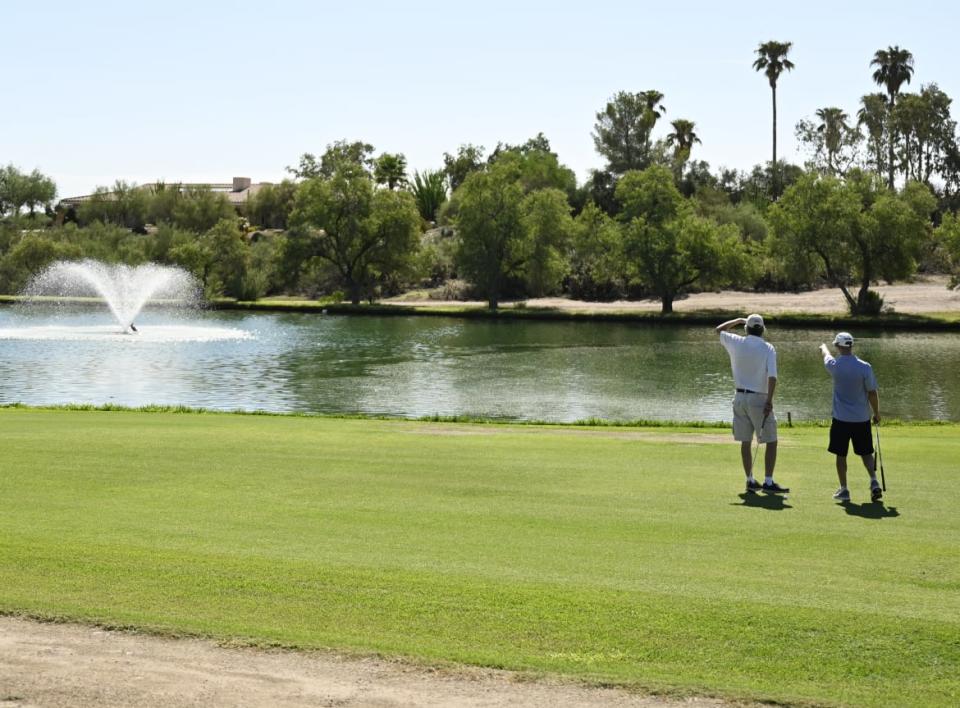Why Golf Might Not Survive the 21st Century

The sport of golf today evokes images of lavish country clubs and pristine greens which often alter and dominate environments that can’t sustain them. But the game’s history predates land-moving bulldozers, industrialized irrigation, even sprinklers and lawn mowers. Golf can trace its origins back to the late Middle Ages, when it was a stick-and-ball game played in the rolling hills of Scotland. Birds and insects flew nearby and ate native plants, which grew freely on the greens.
“Golf, traditionally, is a very environmentally friendly game,” Jason Straka, principal at Fry/Straka Global Golf Course Design, told The Daily Beast. Early courses were found environments, as golfers would discover clear, flat land and find ways to play around obstacles without moving or altering the earth. “The environmental impact was essentially negative,” he said.
Nowadays, golf is a favorite boogeyman of the environmental movement, seen as a symbol of water-wasting opulence enjoyed primarily by the wealthy. Golf courses in drought-parched areas in the American Southwest and southern Europe have been targeted with municipal water cuts—and, at times, accused of evading them. In August, Extinction Rebellion climate activists descended upon the Vieille-Toulouse golf club and the Garonne des Sept Deniers golf course in southern France, filling their holes with cement and tearing up greens to protest their water use as the region suffered a historic drought. While dozens of villages faced water shortages, golfers enjoyed a privilege “worthy of another world,” they said.
Why the Future of College Sports Is to Become Corporations
Golf doesn’t use as much water as hydro-villains like industrialized agriculture, but it certainly gulps down far more than its fair share. Golf courses use more than 2 billion gallons of water per day for irrigation, or about 0.5 percent of the total water withdrawn in the U.S., according to figures published by the United States Golf Association (USGA). While water usage varies heavily by region, up to half of all golf courses in Arizona have exceeded their yearly water allotments over the past two decades, despite shortages of the Colorado River water the state relies upon, the Arizona Republic reported in July. Many Arizona courses hit with water cuts have vigorously fought back.
Leading golf organizations, including the USGA, claim that golf courses at large have reduced their water use. But water levels used to maintain courses in the Southwest and Southeast have remained mostly constant since 2005, according to a report released this year by the Golf Course Superintendents Association of America. And most golf courses still pull their water from ponds, lakes and wells. The same report showed that just 21 percent of water applied to U.S. golf courses in 2020 was recycled, and that number remains low even in drought-prone areas like Phoenix.
Modern golf courses are often artificial environments, relying on non-native grass and plants that suck down water and disturb wildlife. It’s an utterly unsustainable path—one that’s led many golfers and course designers to embrace the idea that, to survive, golf will have to learn from its own origins.
In 2015, the city of Thousand Oaks, California hired Straka’s firm to renovate Los Robles Greens, its municipal golf course, after being ordered by the state to cut water amid a historic drought. The firm reduced the course’s irrigation by 25 percent and replaced dozens of acres of turf with thousands of native and drought-resistant plants, drastically cutting the course’s use of fertilizers and pesticides in the process.
For Straka, making golf courses greener is his natural life’s work. He grew up in rural Ohio camping and canoeing, fishing and swimming in farm ponds in his backyard, and playing golf. Spending his childhood between the wilderness and the links led him to combine his passions, he said—especially as his experiences at local family-run golf courses taught him the game could be low-tech and integrate with nature. “They didn’t have this elaborate maintenance budget,” he said, “and so things are a little bit more down to earth and of the earth.”
During his research at Cornell University, Straka stuck lysimeters (large round tubes that measure water movement) into the ground to test different fertilizers and see which ones retained the most water and captured the most nutrients. “We would figure out which ones were not only the best agronomically, but also the most environmentally friendly,” he said. In the early 1990s, the USGA and other major golf bodies began embracing sustainability, funding research on golf design features as meticulous as correctly planking timber bridges across wetlands so that sunlight penetrates below, encouraging salamanders to cross fairways.
How These Former Foes Are Teaming Up to Solve a Middle East Water Crisis
Straka insists that every golf course actually does carefully consider its environmental impacts. Water, after all, is expensive in the Southwest and other arid environments where golf is popular; course owners say they spend hundreds of thousands of dollars on water, and some California courses reportedly spend up to $2 million annually, giving course owners plenty of impetus to integrate low-water landscaping.
And even in parts of the country that aren’t facing drought, there is a push to find new ways to simply use less. Fry/Straka recently renovated the Union League National Golf Club of Philadelphia, bringing over a million native plants onto the site from a nearby nursery to lower the course’s ecological footprint and preserve animal, bird and insect life
Non-golfers “don’t know what goes behind the scenes,” Straka said. “There’s this assumption that [golfers] don’t care. That’s not the case at all.”
But golf has been slow to shed its dirtiest practices. For example, most existing courses can’t simply convert to recycled water without building prohibitively expensive pipelines, unless the municipality they rely upon does so first. And in some areas, such as the French clubs targeted by Extinction Rebellion activists, golf courses have even obtained exemptions from drought-related water cuts.

Golfers play a round at Rancho de los Caballeros Golf Club on August 17, 2022 in Wickkenburg, Arizona. Due to worsening drought crisis the Interior Department is asking the state of Arizona to cut appropriately 21 percent of the states annual apportionment to Colorado River water.
The Scotland-based GEO Foundation, which promotes sustainable golf and certifies golf courses, gave a presentation on golf’s environmental innovations at last year’s COP26 summit in Glasgow. It’s certified courses from Portugal’s Ombria Resort, which recently restored its riverside plant habitat and opened on-site native plant nurseries, to Vietnam’s Hoiana Shores, which completed a luxury coastal course using only locally sourced building materials.
Another organization, Audubon International, certifies golf courses in the U.S. by charging course owners fees for a certification of environmental sustainability. But the organization, which is sponsored by the USGA and several soil and turf companies, has been accused of certifying courses that fail to follow minimal wildlife protection standards, in some cases allowing hundreds of birds to be killed.
If you’re surprised to hear that the century-old bird conservation group is working with golf courses like this, you’re not the only one—and you’d be mistaken. Audubon International is not to be confused with the National Audubon Society. In fact the latter has accused the industry-linked upstart of trading on its name. The similarities have frequently confused people into falsely believing golf courses have received Audubon Society stamps of approval.
The National Audubon Society’s current CEO, Elizabeth Gray, told The Daily Beast the group has no association with Audubon International and does not “endorse, support or partner with them on any of their activities or certification programs.” Golf courses “must be managed responsibly to mitigate harmful impacts on the natural resources” that lead to habitat loss for wildlife such as birds, she said. The National Audubon Society went to court to try to block Audubon International from using any name connected to its namesake, the ornithologist John James Audubon. The bird conservation organization lost in a summary judgment. Audubon International did not respond to a request for comment.
Still, branches of the National Audubon Society do work with golf courses to protect bird life, and USGA studies have shown that water hazards on golf courses can provide habitats for native amphibians like newts and tadpoles, who help maintain courses by consuming algae and plant material that threatens to clog waterways. Others like salamanders feast on mosquitoes, keeping them from feasting on annoyed golfers.
Still, progress is happening far too slowly. And besides, most golfers still want eye-popping, carefully manicured greens—not the weed-strewn hills and unpredictable bounces of Scotland circa the Middle Ages.
Some courses have addressed this by applying colorants to grass during winter months, rather than using large amounts of water to keep turf green on its own, Janeen Driscoll, the USGA’s director of brand communications, told The Daily Beast. The USGA has worked with several universities to research more sustainable turf that uses less water but retains the emerald green color that golfers love.
But it will take a shift in perception for golfers to begin embracing a more natural, less artificially vibrant game. And while GEO has certified several large U.S. golf tournaments, the majority of courses on the PGA Tour and its upstart competitor, Saudi Arabia-backed LIV Golf, have made no sustainability commitments.
Ari Fleischer Ripped for 9/11 Announcement After Being Hired by LIV
The truth is probably in the middle: building new courses that avoid the mistakes of their predecessors and retrofitting existing courses to use less irrigated water and swap out water-intensive crops for native plants.
Straka insists that golf’s modern excesses are merely symptoms of a larger problem. “Golf is just one aspect of suburbia and housing communities and everything that exploded after World War II,” he said.
And when activists insist that golf courses be shuttered in areas running low on water, Straka bristles, believing there are more worthy targets than a game communities can enjoy together.
“The bigger question isn’t whether golf belongs in Phoenix,” he said. “The bigger question is whether Phoenix belongs there.”
Get the Daily Beast's biggest scoops and scandals delivered right to your inbox. Sign up now.
Stay informed and gain unlimited access to the Daily Beast's unmatched reporting. Subscribe now.

 Yahoo News
Yahoo News 
